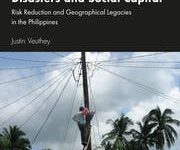Book. Carolyn Kousky: Understanding Disaster Insurance

ENVIROMENTAL OUTCOMES In the coming decades, risk management will be central to economic and social progress. We are at an inflection point where our failure to take early and strong action on climate change and environmental degradation has locked us into a range of escalating risks. Risk management is most successful when it carefully unites risk education and communication, risk reduction, and risk transfer. Carolyn thinks about these integrated aspects of risk management to improve social and environmental outcomes. She believes the multiple crises now gripping our planet are not small and require broad and deep attention from all sectors. Her research and policy work focuses on analyzing the challenges, developing innovative solutions, finding pathways to scale impact, and developing cross-sector and cross-disciplinary partnerships focused on securing positive change.
World Economic Forum podcast 2023
In this episode, Carolyn Kousky, the Associate Vice President for Economics and Policy at the Environmental Defense Fund, discusses her new book, Understanding Disaster Insurance: New Tools for a More Resilient Future. It examines how insurance has become a crucial part of our society and an industry that will be increasingly relied on as the climate crisis exacerbates disasters ranging from hurricanes and wildfires to coral reef decay and deforestation.
Podcast transcript
Beatric Di Caro: From the World Economic Forum. I’m Beatrice Di Caro and this is the Book Club Podcast. In this episode, my colleague Spencer Feingold speaks with Carolyn Kousky, the Associate Vice President for Economics and Policy at the Environmental Defense Fund and the author of the new book, Understanding Disaster Insurance: New Tools for a More Resilient Future. The book dives deep into the world of insurance, examining how insurance has become a crucial part of our society and an industry that will be increasingly relied on as the climate crisis exacerbates disasters ranging from hurricanes and wildfires to coral reef decay and deforestation. Kousky details different policy frameworks around the world, and discusses how robust and balanced insurance systems can not only help communities rebuild after a disaster, but help them avoid disasters in the first place. My colleague Spencer begins by asking her what inspired her to write the book.
Carolyn Kousky: The world seems to be getting riskier. And I think a large part of that is related to climate change and the changing frequency and intensity that we’re seeing around many natural hazards. But it is broader than that. Insurance and the role of insurance becomes ever more important because as we’re seeing more frequent and more intense disasters, the need to have the financial tools to recover from them becomes really critical. Yet at the same time, those exact events are now stressing disaster insurance markets, making it harder to provide it and provided affordably. So we have this tension right now in insurance markets that I think often requires policy solutions.
Spencer Feingold: One thing you wrote that kind of caught my eye is that insurance is not risk reduction, it’s just risk transfer. And specifically, you write that risk transfer is foundational to a thriving economy and a thriving country. So do you mind going over what that kind of risks transfer looks like? And do you think most countries, especially countries in Western Europe or the US, have that necessary risks transfer for a thriving society at this moment?
Carolyn Kousky: To kind of back up and think about insurance more broadly. As you noted, insurance is really the transfer of risk from one entity, like a person or a household or a business to another entity that’s better able to manage that risk, often through risk pooling and other mechanisms. That’s typically an insurance company. The book’s a bit broader than just insurance because there’s actually many mechanisms to transfer risk, and the formalization of risk transfer and insurance is just one of them. We talk about it in the book also, you know, using financial instruments to transfer risk. There’s also a lot of informal risk sharing and risk transfer that just happens in general in societies. But that ability to kind of transfer risk, which in effect ends up smoothing your income because you pay a little bit in the good years so that when you experience a severe financial shock because you need to recover from a disaster, you have the funding to be able to pay for those insurance is really fundamental to a lot of economic activity that happens in society. So thinking beyond just disasters right in the US and other countries, you can’t take out a mortgage to buy a home unless you can get homeowner’s insurance because the bank’s not going to lend to you without the protection of that property insurance policy. You know, surgeons aren’t going to undertake very complicated new procedures unless they’re protected against the cost of lawsuits through their medical liability insurance. Right. And we’re not going to invest in major infrastructure projects if the sort of builders and owners of those investments had to bear all the risk should something go wrong, should someone get hurt, you know, should they not perform as expected? Should they be damaged before they’re fully built? So there’s all these risks that need that could be financially ruinous for people and the ability to transfer them is what enables that activity to still take place globally.
Spencer Feingold: This protection gap is around 75%, whereas in the U.S. and in North America, which has a very robust insurance market, it’s still up as high as 60%. So you can just kind of explain that insurance gap. And one thing you write, which I quite like, is how the insurance is kind of a Goldilocks product, not too much, but not too little. And so are we are we even close to finding that sweet spot or how far away are we to get the market where it needs to be to face our world today?
Carolyn Kousky: Globally, a very large share of disaster losses. The economic cost of disasters are not insured, and that’s true even in countries with very well-developed insurance markets like you were talking about the US and Western Europe that in general have sort of high uptake of a range of different types of insurance products and lots of insurance offerings. And that’s because disaster insurance is trickier than other lines of insurance. So I talk about this a little bit in the book, but because the losses from disasters happen to lots of people at the same time. So when you get into a car accident, as I mean all your neighbors did, but when you suffer from a flood or wildfire, right. Everyone in your community probably is, too. And those losses can be really severe. That combines to mean that in a disaster year, there’s a huge number of claims payments that need to be made. Right. And in order to cover those claims without going bankrupt, insurance companies have to have access to a lot of capital in those high loss years. But that means that they have to use different mechanisms than what was really the foundation of insurance. And the foundation of insurance was really around this concept of risk pooling like everybody puts a little bit in every year and every year something bad happens to someone and they can take the money, but it’s never the you know, everyone doesn’t all suffer a loss at the same time when everyone suffers a loss at the same time, that actually undermines a lot of the mathematical laws that underpin insurance and makes it harder. So insurance companies do a number of things to have access to that capital. They buy insurance themselves. That’s the global reinsurance industry. They might use financial products to transfer risk into the financial markets. They have their own equivalent of a savings account like they hold their own reserves. But all of those things are costly and those costs are passed on to the policyholder. And so that makes disaster insurance one more expensive than insurance that doesn’t have. A sort of catastrophe potential. And in the extreme, it can mean that really it’s not something the private sector can offer because the bankruptcy risk is so high. And that gets a little bit, too. Part of the Goldilocks story, they’re right. Like we can’t insure risks that are just globally catastrophic because there’s just no amount of capital in the industry that could cover that type of risk. And that was a conversation we saw as COVID was unfolding. And there were all these business closures and lots of business wanted all that interruption to be covered by insurance. But when you have a global economic shutdown, that sort of really violates principles of insurability. At the other end of the extreme, it’s hard to insure really small risks, too, right? Because there’s a lot of transaction costs that go along with insurance. And that seems maybe trivial, like we’re not going to insure breaking a plate in our kitchen. It’s too small. But actually solving that challenge was really important to thinking about how to get insurance into sort of lower income households and communities and maybe even have higher transaction costs because they’re harder to access. So to make sure that insurance is available to everyone. So finding that sweet spot is hard and harder with disasters and even harder as climate change just making disasters worse.
Spencer Feingold: Something that I’ve also been tracking is the cost of these disasters. Hurricane Ian, I believe, is the 15th billion dollar disaster in the United States. Why do you think they’re getting more expensive? Is it just the intensity of the disasters because of climate crisis or just the nature of where we build cities today?
Carolyn Kousky: It’s both of those things in combination. So we see increased development in areas that we know are prone to hazards and development that’s not built to withstand them. So it’s not just where we build, but it’s how we build. And then that in combination with the changing frequency, intensity, timing, spatial duration of these hazard events is combining to really drive up economic losses in a profound way. And that gets back to how we need to couple insurance and risk transfer with managing that underlying risk. And they really need to be seen as complements because the way to make disaster insurance more affordable and more available is to reduce the underlying risk. And so strong investments in building codes to build safer inland use regulations to not put development in the riskiest locations all enable a better, more robust disaster insurance market. And so we really need to see this collaboration between the public sector adopting these more aggressive risk reduction strategies in order to enable the private sector to offer the insurance to households and businesses.
Spencer Feingold: Yeah, and this is something you briefly mentioned earlier. It’s to be able to confront our world of disasters. Today it seems almost impossible that the private sector can do that alone. Now, a major earthquake in California could bankrupt a insurance provider. So how do you see the balance of private and public partnership coming into the insurance sector? What do you think is the main role of the government? Should they backstop these private companies?
Carolyn Kousky: Yeah, that’s a really important question. And it’s true that there’s almost nowhere in the world today where there’s sort of a fully functioning private disaster insurance market with a high degree of take up. We see governments intervening in disaster insurance markets in many different ways and often being the ultimate provider of disaster insurance when it just proves too difficult for the private sector to offer or unable to offer at a price that people are willing and able to pay. Right. So when you see those kind of breakdowns in the private market, the public sector often steps in. If you look in the US here, for example, they’re starting to be warning signs about places where the private sector is still providing insurance, really having trouble. Now as these hazard risks escalate, I’m thinking about insurers pulling back and raising prices and high wildfire prone areas in California. I’m thinking about bankruptcies that we’ve seen in Gulf Coast states in the US, like Louisiana and Florida and globally. We’re seeing similar kind of stresses in the high risk areas. So that does mean that there’s a really important public sector role and there’s often been a thought on the part of policymakers that they should help make disaster insurance available and affordable to people. And that’s because of the really important role that it plays in recovery. Without insurance, we know that recovery is much more difficult and can be slower and delayed and pose enormous hardship on households and on businesses. And so insurance is really critical for people’s well-being and to get economies going again after disaster event. That said, there’s also concern that we don’t want to underprice insurance or make it available or cheap in places where it really is incredibly risky because we don’t want to create a moral hazard and sort of bring people and development into high risk areas which would actually be more economic to sort of not have economic activity in those places. So that’s an important balancing act. And countries around the world have taken really different approaches to this. So in some countries like the US and Britain, there’s sort of really a payroll by parallel approach. So we have government programs for different specific hazards, a flood insurance program, a separate program in California for earthquakes and so on other countries. Take a very different approach, though. Like if you look at France and Spain, they require all natural hazards to be included in a standard property policy for the homeowner. And then, as you were saying, they provide that kind of backstop for insurance companies so that they don’t go bankrupt. I’m kind of partial to that model. I like it a lot because of a couple of reasons. One, I think it makes it easier on the consumer. There’s something really nice about having you go by your property policy. You want all the damages included, right? But then but then we do need government coming in at the tail end to protect against bankruptcy or the private sector just wouldn’t play right.
Spencer Feingold: They would often, it seems like today to you like it’s climate disasters. So it’s like, how do you know what destroyed your house? Was it the flood? Was it the electrical fire was, you know, when a hurricane comes through, I mean, how do you pass this incredibly difficult…
Carolyn Kousky: Yeah. Lots of lawsuits here in the US around those very issues. Right when the house is just gone. Yeah. One policy that’s for wind and one that’s for water.
Spencer Feingold: Yeah, that’s incredible and quite grim. What’s interesting, too, is I think like, how do you create an insurance ecosystem that covers the entire community? Because if your community is devastated by a hurricane or something like that and okay, I have insurance, I can rebuild my house. But if if my community is devastated, then there’s no point rebuilding my house in a devastated community. So is that another kind of part of where you have to have the public private come at it from all angles to ensure that communities as a whole can rebuild?
Carolyn Kousky: Yeah, communities as a whole need to rebuild. And that’s sort of the residents and the businesses and then bringing back the infrastructure and the local government stuff. Right. And we see that disasters that are really catastrophic and hit all of those aspects really end up being much more devastating, obviously, and make economic recovery harder. One of the challenges that we’ve been focusing on quite a bit recently is that the households and businesses that need insurance, disaster insurance the most because they don’t have access to other forms of financing for recovery, they might be locked out of access to credit. Right? They can’t take on additional debt. They don’t have enough savings built up. So they don’t have these other sources really need insurance the most, and yet they’re the least able to afford it. So how can we kind of solve that problem to ensure greater equity in recovery? And I think that that problem really is where we need these partnerships across sectors.
Spencer Feingold: So, yeah, I mean, that kind of gets you into next point. I was going to ask about this concept of micro insurance, which I thought was really interesting, especially how low income countries with low populations, but especially countries like island nations that are really at risk from these climate disasters. Do you mind explaining what micro insurance is and maybe touching on like the Caribbean catastrophe risk insurance facility? I thought that was interesting how you can pool risk for these small nations that maybe don’t have the means to recover, but they’re the most vulnerable.
Carolyn Kousky: Yeah, So these solutions all draw on something called parametric insurance, which is a little bit different than what some listeners may be familiar with. A lot of insurance, at least in the U.S. and I think in quite a few Western European countries is what’s called indemnity insurance, which means the amount that you get paid is directly related to the amount of damage you have. So here, if like a tree fell on my house, an actual loss adjuster, a person from the insurance company shows up and looks at it and they pay me the amount of the damage. Parametric insurance is really different. It gives you a set predetermined payout based on an observable metric of the hazard itself. So something like when wind speeds within so many miles of this point exceeds some threshold, you automatically get a payment. Or when flood gauges have some reading, you automatically get a payout. And there are some pros and cons of this. The benefits are speed and flexibility because the payout is tied to this observable metric, often by an independent third party that can be measured right after the disaster. You can get money much more quickly. So getting money quickly is one benefit of parametric policies. The other is flexibility. They can provide. The dollars, you know, are not tied to the specific loss, so they can be used for anything. And the benefit of that is that there are lots of non property losses from disasters and right now a lot of our standard sort of insurance infrastructure doesn’t really handle those losses really well. So if you have a standard homeowner’s policy, it will cover the property damage. But people are also facing losses of higher commuting costs because the infrastructure is out and they had to rent a car or have this longer commute or the power grid was down for a long time and they had to buy a generator and fuel for it. Or they also lost income at the same time because businesses were interrupted or they had to pay for temporary housing while their home was being rebuilt or evacuation expenses. I mean, the list can really go on and on in terms of the cost that households face. And so parametric policies offer up a way to help transfer some of that risk and get households or businesses financing for this. You know, like hotels have sometimes used parametric policies to for business interruption losses that are not damaged but they no tourist come because there was a big hurricane or whatever. So so that’s kind of parametric. The one problem with it, though, is that the payout is not tied to the loss. So. I need to be clear. It can’t replace indemnity policies. You know, like a bank is always going to require a standard homeowner’s policy when you take out a mortgage. But it is, I think, best thought of as another tool in the toolbox. And so sorry with all that background. Now to get to the kind of applications and you mentioned two that I think are nice examples. So one is micro insurance, which is almost always parametric. And the idea here is how do we get sort of small coverage, small premium payments to poor populations and often the transaction costs associated with doing loss adjusting or something on that kind of policy would swamp to come back to this Goldilocks thing. Any sort of, you know, would make it sort of impossible financially to offer a product like that. But with parametric products, and we’ve seen these rolled out in pilots and programs around the globe now often referred to as weather index products. Some independent measure of the hazard triggers, the payout and the payout can just be made without anyone visiting, without anyone going there. Often, you know, some of these are often also on mobile phones, so they’re kind of mobile platforms. They can reach the unbanked because you can just have money into a mobile money type platform. So there’s a lot of innovation happening with those really been developed in the Global South. But we’re actually seeing now that that sort of learning come back into developed countries because we have populations here in the U.S. that are not served and aren’t able to access disaster insurance market. So, for example, Puerto Rico has set up regulations to enable a micro insurance market if they own the US state or territory to do so. So far. So micro insurance is like very small policies, but you can also have policies that are big, sort of like all the way up for countries. And we’ve seen that in these risk pools that have been set up. So one is in the Caribbean where different Caribbean and Latin American countries come together and they can purchase these parametric insurance policies at the level of the country. We see dynamics with international aid that we also see replicated at a smaller scale with sort of federal aid to households, you know, at a country scale. But internationally, often after disasters, the assistance to these either smaller or lower income countries that can be really financially hit by a huge disaster, can be slow, can be poorly targeted to need. Right. And so parametric insurance, again, is a way around that. So these countries can purchase these policies for different types of disasters like hurricanes or earthquakes that might impact them and then get payouts right away to begin rebuilding and recovery in their country. And so we’ve seen that been working really successfully in the Caribbean. There’s a similar pool in Africa and one in the Pacific as well.
Spencer Feingold: Fascinating. So just to switch gears a bit, but we’ve been talking kind of about how insurance is key to this recovery, because I’ve seen these in the climate world we’re facing today. But I’m curious, you write kind of about how the insurance market can also be leveraged to put forth this nature positive world. It can be leveraged to actually combat the climate crisis as we do transfers in our energy sector or transfers in how we consume products. Do you mind speaking about that as well? I just find that quite fascinating about this kind of nature positive world in the way that insurance can play a role there.
Carolyn Kousky: Yeah, I think there’s actually a number of ways insurance can play a role there. One is that insurance companies are enormous holders of capital, right? They have those reserves that you’re talking about. They have to hold a lot of money to be able to pay claims. And they need to invest that generally pretty safely because you need that money there to pay claims. So they can’t be, you know, gambling too much with it. But there has been a lot of work now on helping direct those investments into companies that are, you know, engaging in nature, positive activities that are part of the energy transition sort of and also, you know, as part of the general global divestment discussions, sort of pulling their investments away from firms or sectors that we know are not helping or on the sort of path to a no carbon economy. So that’s one thing is kind of thinking more carefully about their investment strategies. And that’s something that we’re seeing, you know, across the globe, across all large holders of capital, right? That’s kind of an ongoing discussion. And insurers are just one more big player in that. A second one that’s unique to the insurance sector is where and when and how much they charge for insurance. And so that’s called underwriting. So when an insurance company chooses to insure a project or a company in a certain location, in a certain sector, and how much they charge for it are all the underwriting decisions. And we’ve now seen an activist movement emerging that began pressuring insurance companies to stop underwriting fossil fuel companies or other carbon intensive sectors. We’ve also seen pressure to not underwrite other types of extremely ecologically harmful activities. And so in response, insurance companies have begun to adopt sort of restrictions on their underwriting. We’ve seen some companies, for example, agree to refuse to insure any vessel that has been tagged as engaging in illegal fishing. We’ve seen some insurance companies agree to not insure certain types of projects that are with, you know, in close proximity to World Heritage sites. And we’ve also seen a number of reinsurance and insurance companies now make commitments around climate. Many have said they’re not going to insure new coal. We’re seeing varying degrees of types of underwriting restrictions emerge around oil and gas, for example. But some companies are also thinking carefully about how to use their underwriting standards and approaches as leverage to help the companies they’re insuring on that transition. Right. So how can we actually help some of these companies and sectors that are important to the economy but we know need to be moving away from carbon-intensive activities and maybe insurers can help them in that process. And similarly, maybe they can help sort of clean up dirty industries or help other companies adopt more nature-positive approaches. But the other flipside of that is like, let’s proactively help provide the insurance needed for new good stuff. So new clean tech or other new emerging technologies that might have the potential to be really transformative in solving environmental or climate problems.
Spencer Feingold: When I was reading I found it fascinating this idea that you could almost insure a coral reef or insure a a forests, how would that work and what would that look like in practice?
Carolyn Kousky: Yeah, So that’s another one of these kind of new approaches that people are thinking about right now. There was a pilot that emerged that I’m sure you’ve read about that I talk about in the book, where the Mesoamerican coral reef was insured through a number of partners working together, creating a trust that actually helps manage the beach and the reef. And one of the things they did was purchase a parametric insurance product on the reef to use the funds to invest in reef restoration. So the idea is that a very strong hurricane can actually damage reefs and break off pieces of coral. But if you get divers in the water really quickly after a hurricane, they can kind of attach some of these coral. And so the idea is to have funds immediately for that type of restoration work. So this idea of insuring nature itself is a really interesting concept. Some of the challenges, though, are thinking through where that model is really important and helpful because there’s a number of things. One is that some of the biggest challenges facing our natural systems are really to come back to this Goldilocks idea again, not insurable. So reefs can get damaged by storms, but the biggest threats facing reefs, right, are things like ocean acidification, warming, leading to these bleaching events. And insurance can’t help with those. And those are the real drivers of reef decline globally that really need serious environmental attention. And I don’t think insurance is the tool for solving them. So it’s important to be clear about where insurance is a good tool, but it’s equally important to be clear about where it’s not and where we need other types of tools to solve our problems. Right? But in situations where money quickly can help do something good, that’s where insurance can play a role. That’s the sweet spot.
Spencer Feingold: I’d love to just ask you a final question. You write how people are just bad at thinking about risk. They just either overestimated, underestimated. We kind of don’t understand. Why do you think that is?
Carolyn Kousky: Yeah. There’s a large body of behavioral economics and psychology that has delves into these challenges that people seem to have in thinking about risk. We seem to be pretty bad thinking about probabilities in general. We tend to be overly optimistic. This is a big one for disasters. People always think disasters are something that happened to someone else. And we also just don’t like to think about bad things happening when the sun is shining and things are going well. And that’s a really big one with disasters because it’s very difficult to motivate preparedness because it never rises to the top of the priority list when a disaster is not imminent. But beyond that, with insurance, we also have this problem that nobody likes to buy insurance, right? You are buying a product that you hope to never use. So there’s not a lot of joy in that. Right. And so you have to kind of help get people comfortable with this idea of risk management and that we’re buying this product as this protection in case something goes wrong and we hope nothing goes wrong, but we really need that protection just in case. And that can be difficult sometimes.
Beatrice Di Caro: That was author Carolyn Kousky speaking to my colleague Spencer Feingold. Big thanks for joining us on the World Economic Forum Book Club podcast. Please subscribe to this podcast. Leave us a review and don’t forget to join our book club on Facebook and our podcast club also on Facebook. Don’t forget to search out our sister podcasts, Radio Davos and meet the leader wherever you get your podcasts. This episode of the Book Club podcast was hosted by myself, Beatrice Di Caro, and by my colleague Spencer Feingold. Production was with Gareth Nolan and big thanks to our podcast editor, Robin Pomeroy. We’ll be back soon, but for now. Thank you for listening and goodbye.
Share:










